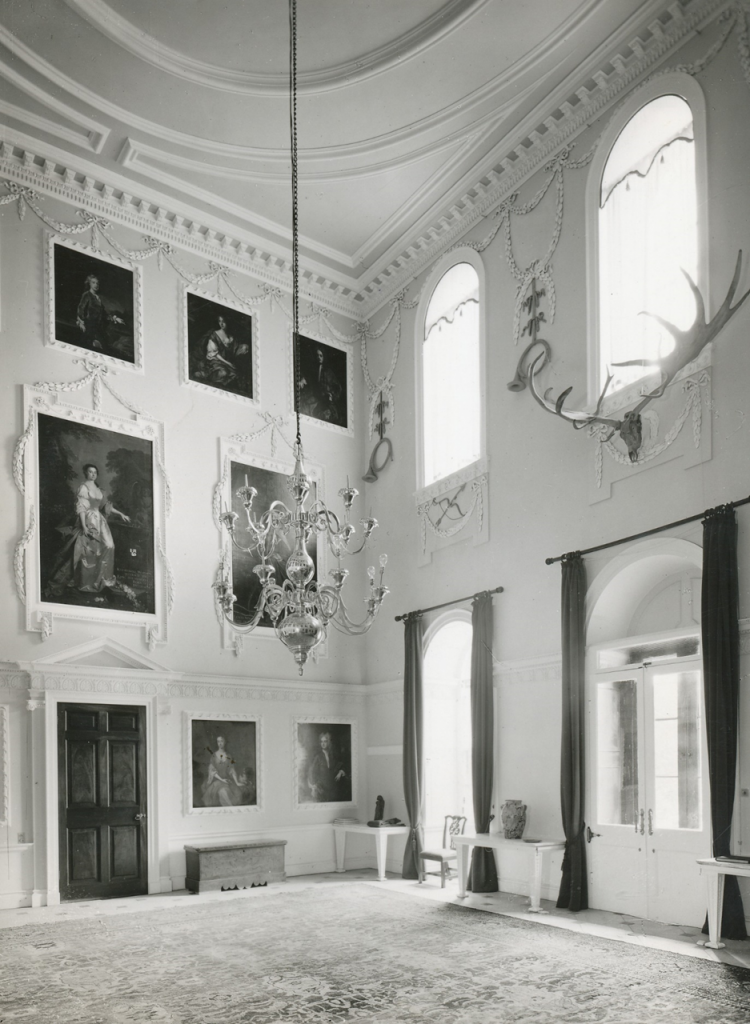A feature older than the house itself hangs in the Saloon, or portrait gallery of Kings Weston house; it is in fact around 13,000 years old! This incredibly ancient artefact is the fossilised skull and horns of the extinct Great Elk. Today the antlers are integrated into the architectural treatment of the Georgian interior, as they have been since the hall was redesigned in 1769 by the architect Robert Mylne, but they’ve been at Kings Weston longer than that.

The Southwell family who built the house were from a dignified Irish family in southern Ireland, but their wealth suddenly increased when, in 1703, Edward Southwell married Lady Elizabeth Cromwell. She was a wealthy heiress to a fortune, with an income of £2000 a year – around half a million in today’s money. Most of her family’s wealth came from extensive estates around Downpatrick in northern Ireland; these lands would remain the main source of income for the Southwell family for the duration of their time at Kings Weston. After Elizabeth’s early death in 1708, all her wealth passed on to her husband, Edward, known by family and friends as Neddy.
Neddy was a very learned gentleman. Like his father, he was a member of the Royal Society, the world’s oldest scientific academy. It was, no doubt, his reputation and interest in the sciences that led Mr James Kelly, probably the estate steward for the Downpatrick estate, to write to him in 1725:
“Since I know you to be a gentleman very curious in searching after nature I thought it would not be unacceptable to give you an account of those appearances that we meet with in searching for marle, now in so plentiful a manner found on your estate in this country.
Among the marle, and often at the bottom of it, we find very great elk horns, which we, for want of another name, call elk horns: where they joyn the head they are thick and round; and at that joyning there grows out a branch of about a foot long , that seems to have hung just over the beast’s eyes: it grows round above this for about a foot and some odds, then spreads broad, which it does in branches, long and round, turning with a small bend. The labourers are commonly so busie that they rarely bring them up whole; yet I have one pretty well, of which I send you an icon done as well as I could, but not so nice as I could with. We also have found shanks and other bones of these beasts in the same place.”

This wasn’t the first account of Giant Elk being discovered in Ireland, the first such being in 1695 when physician Thomas Molyneux made the first scientific descriptions from antlers discovered near Dublin, but the letter was of such interest that I was presented to the Royal Society and published in their transactions in December the same year.
We can’t be certain that the elk skull at Kings Weston is the same that Mr Kelly salvaged from the marl workings, but there’s a strong likelihood that it was sent back to Neddy for his closer study. If it wasn’t the same one, then it would have been another example excavated with greater care, for preservation. A close inspection of the skull where is hangs today reveals it wasn’t brought up whole, with a variety of metal plates of various dates holding it together on the wall. Some of these are likely to be from its original reassembly, with other pieces appearing to have come from other specimens, to make up a complete skull for display.
Whenever it arrived at Kings Weston it was immediately a trophy of great interest and was hung prominently in the saloon; this would have been the hall in its original form, as designed by Sir John Vanbrugh, and with stone walls, arcades, and architectural details. At the time there were a pair of fireplaces, one either side of the present later Georgian one. This explains the description of the room immediately before it was refurbished to its present appearance in 1769:
“From the landing place I passed to Kings Weston, the feat of Edward Southwell, Esq; built by Sir John Vanburgh. It is in his heavy stile; the hall the only tolerable room, and that rendered totally useless, by a vast echo. Before one of the chimneys, is a prodigious pair of elk’s horns, dug out of a bog in Ireland”
(Arthur Young: A six week tour thru the southern counties of England and Wales)

It must have presented quite a lopsided appearance for thirty-so years, a huge set of antlers above just one of the fireplaces in the hall, but this was rectified when the architect Robert Mylne was trusted with the redesign of the room as a grand portrait gallery for the family. He incorporated the skull and antlers into his designs, locating them immediately above the entrance door. To it were added a series of other stucco motifs, four horns hung from plaster swags and bows and arrows amid festoons, all moulded by notable plasterer Thomas Stocking. Rather than stand exhibited as an ancient artefact, the skull became read as part of an ensemble of hunting trophies.

Restoration work in 2021 filled the Saloon with scaffolding, allowing closer inspection of the Great Elk fossil. The metal plates holding it together were clear to see; less clear was a scratched signature and date carved into the upper surface of one of the antlers. The date, we think 1834, coincides with the second great family of Kings Weston, The Miles’s, moving in. Perhaps a decorator hired for the refreshing of the interiors took the opportunity to make a bid for immortality by making their mark. Sadly for them the name is virtually illegible. If you can decipher it, we’d love to know!




